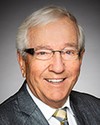Mr. Chair, I want to thank all hon. members in the House tonight for coming out for this very important debate. I particularly want to thank the member for Lambton—Kent—Middlesex and the member for Huron—Bruce who suggested this, as well as members from all parties who had asked that we have this debate.
This is an issue that the hon. member may not understand, but it is an issue that crosses party lines and it is an issue that is of concern to all Canadians. The Government of Canada, as I have said before and I will continue to say, takes this issue very seriously because it is one that I believe all Canadians, whether a farmer or not, believe is of utmost importance to the country.
I want to once again thank the Prime Minister for the work he has done on this in terms of his work with both President Bush and President Fox and for his encouragement and support for the work that ministers have had on this side in terms of trying to get the borders open.
The BSE situation has repercussions right across the country, not only for farmers and farm families or just beef or dairy. In fact representatives of the Dairy Farmers of Canada are in town this week. They represent the dairy producers across this country who have been impacted by this very much. I want to recognize the work that the leadership of the Dairy Farmers of Canada, the Canadian Cattlemen's Association, the Canadian Federation of Agriculture and all farm groups have done on this. They have taken this issue very seriously and I believe have given us here in the House the support that we need to help move this issue forward.
I want to report on BSE and what the Government of Canada has done since our first case of BSE on May 21, 2003. As everyone knows, the situation became much worse when a second case of BSE came about in Washington State. It was after I became Minister of Agriculture on December 12 and it was a time, I can say to all hon. members, that has taught me the importance of the House and working together with members of Parliament to work toward solutions to issues.
This is an issue on which the Government of Canada has moved swiftly. With the support of the Prime Minister, other ministers and caucuses in the House, we have been able to send messages to our international partners about how safe not only the beef is, but how safe all food is in Canada.
We had a situation in Canada where the consumption of beef rose because Canadians understood that Canada's regulatory system was a system they could trust and they knew the beef they ate was safe. That did not come about just because one day consumers thought it would be nice to think that. It came about because of the hard work that had taken place behind the scenes by groups such as the Canadian Food Inspection Agency and people within government who had worked with commodity groups and farmers across the country to come up with ways in which we could convince consumers.
We would not have been successful in getting our beef into other countries around the world had consumption in Canada not risen. It was the rising consumption in Canada that gave other governments the ability to recognize that Canadian beef was safe, and they therefore opened their borders to Canadian beef.
Once we had dealt with the issue in Ottawa, I had the opportunity to sit down with farm groups across the country and talk to them about what more they felt the Government of Canada could do in this situation. They told me, first and foremost, that we needed to get out and market Canadian beef around the world. That is exactly what we did.
I managed to take a couple of my colleagues, the member for Tobique—Mactaquac and the member for Medicine Hat, with me to Korea , Japan and Washington. We met with government officials, the ministers of agriculture in all these countries and the ministers of trade in some countries We talked about what we had done in Canada.
We talked about how we had listened to an international peer review panel that reported on Canada. The panel had given a glowing report on the actions that Canada had taken since its case of BSE. It had made recommendations on which the Government of Canada was moving. These recommendations could give not only Canadians the confidence about eating beef, they also could give the consumers in those countries the confidence that the beef they were eating was probably some of the safest beef in the world to eat.
We managed to convince the Japanese to look at issues other than just the way they handled BSE. Their minister talked about measures that we could take in Canada, not exactly the same measures but similar or equivalent to get our beef into Japan. That was a good step forward and one on which we have followed up.
What I have done since that time is send an inspector, a veterinarian from the Canadian Food Inspection Agency, to Tokyo, Japan to be on the ground. The inspector will work with the Japanese and countries in Asia, to show them what we are doing in Canada and talk to them about what the scientists at OIE, or the international body that regulates this, have said about what Canada has done. The inspector will also try get them to understand the importance of following the science and following what is coming out of the OIE.
We also got an agreement to work with them toward recognizing that the situation such as in Europe was a totally different than the situation in Canada. A group like the OIE could recognize that there is a difference between the risk factors in Europe and the risk factors in Canada. We only had one cow, which happened to be over six-and-a-half-years of age, which happened to get this disease prior to the time when we brought in the feed ban. I explained to people in Japan and Korea that we had a firewall and that firewall was taking the SRMs out of the food system.
We then moved on to Washington and talked with our Mexican and American counterparts. We got an agreement that we would have officials work toward normalizing trade in beef in North America. We also got an agreement from them to work in the OIE and to work together to try to change and get it to recognize we had a different situation in the North American case than that of the case in Europe. Finally, we got an agreement with them to work together in terms of getting North American beef into export markets around the world.
We have followed up on that. We have had meetings again with our American counterparts and we are trying to work through these problems. As many members may know, the international peer review panel in the United States reported and made recommendations to the Americans which were not unlike ours.
In the report of the panel one thing it has said to the Americans is they need to take a leadership role when it comes to trade in this area. They need to show that by opening up their borders to Canada they are following the science and recognizing that the risk in Canada is no different than the risk in the United States. The risk is so minimal that Canadians can continue, and Americans can also continue, to have the confidence in the beef they eat.




